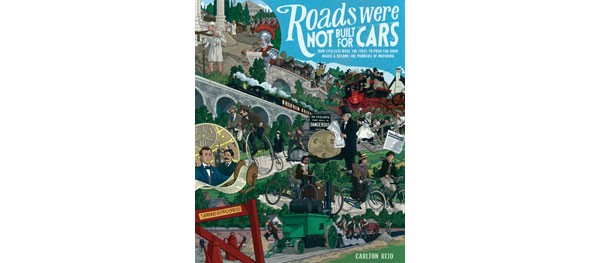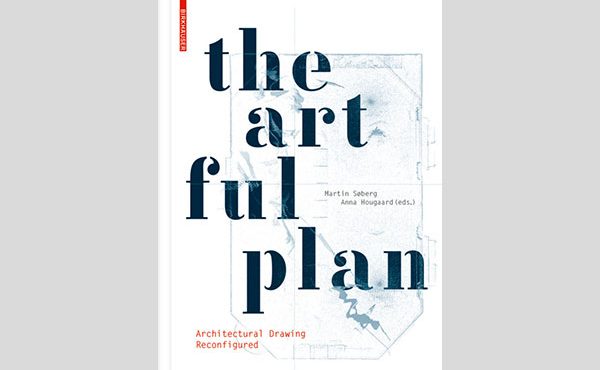
Author: Carlton Reid (Island Press, 2015)
There has been a lot of discussion recently around getting more cyclists on the roads, be it for health, environmental reasons, or relieving traffic congestion. We’ve seen the addition of various bike-related infrastructures—from bike lanes on streets to new “lifts” or pulley systems that help haul a bike up steep inclines—so it wouldn’t be a stretch to say that bikes are playing a larger and larger role in road design and operations. But this relationship suns deeper, and in Roads Were Not Built for Cars, readers are taken through a massive history lesson, drenched in facts and anecdotal information, around just how influential bikes have been throughout their time.
From the moment one picks up the book, it is evident that Carlton Reid has gone to incredible lengths to demonstrate how bikes played a pivotal role in creating the roads that are now claimed by the automobile (a term we’ve come to understand as meaning “cars”). There isn’t a day that goes by it seems that there isn’t a debate raging somewhere about bikes on roads, but this book steps back from that a bit and answers the who-came-first question about bikes and cars, in an interesting fact-filled journey.
Roads Were Not Built for Cars started from a Kickstarter (crowdfunding) campaign, in 2013. This allowed Reid to fund his research into the history of biking and roads, which is what makes the book stand apart from other similar reads. The book is broken up into simple and understandable chapters that move through history and tell some of the untold and lesser known facts about automobiles, methods of paving, technology, and one of my favourites, succinctly titled “Without Bicycles Motoring Might Not Exist”. These chapters are followed by an epilogue, and then three appendixes which span almost fifty pages, and make for a great resource to look back on.
While the structure of the book is simple, it is massive, and that is both a positive and negative attribute. There were times where I was absolutely riveted, I couldn’t peel my eyes from the page. For instance, in the chapter “Mastodons To Motorways”, some light is shed on how people viewed motor car use in the early 20th century. Reid writes that in 1904, “an American magazine called automobile drivers ‘a reckless, bloodthirsty, villainous lot of … crazy trespassers’”, continuing that a “number of localities banned the ‘devil wagon.’” It was interesting to read this, knowing some of the venom that gets spit in the direction of bikers nowadays. There will always be those that don’t follow the rules of the road (which they helped create), but it’s sobering to see that individuals (walkers, horseback riders) in the 1900s had a similar view of the motor car.
As I mentioned, though, there were also parts of the book where the facts became overwhelming and the pages seemed encyclopedic to the point that it was hard digest everything at once. The sheer amount of factual information is truly awe-inspiring, but certain sections were treated with more wit and literary savvy than others.
That being said, I think I may have missed out a little bit by reading the soft-back, print version of the book instead of the e-book format. On his website, Reid talks about the latter, and after seeing this, I think that perhaps with all the supplemental material that accompanied the digital version, these heavily fact-laden sections may have had a bit more flow to them. Although both the e-book and print versions contain the same content, the former seems to have more accompanying images, with a lot of the factual information has been placed within them, such that readers can scroll around the image, make it larger, and/or pop up windows to show facts in context. There is even an interactive map of London from 1906 so you can zoom in and look through different road surfaces and see more facts. After watching the video, the book seemed to take on a new life for me, and it was almost impossible to compare the two.
This aside, the fact that many of our roads advances came from the world of bicycles was surprising to me, but not shocking. The book was filled with information that makes you stand back and ponder just how much our society has changed into a world dominated by motor cars or automobiles as we refer to them now. The fact that some of the largest policy makers at the turn of the 20th century were bicyclists, that cyclists pushed for paved roads, and that, in the early 1900s, car enthusiasts and bicycling enthusiasts were usually one in the same is astounding….almost unbelievable in todays contested climate on road domination.
Although it is clear that, for the moment, cars have overtaken bikes in their road dominance, I found myself asking, “for how long?” by the end of the book. We know there are other technologies on the rise, and we know cycling is making a massive resurgence in many communities across North America and the rest of the world (where it isn’t already still the primary mode of transport). So, I was left wondering, is the car the next technology to be surpassed, and what will come after it?
Overall, Roads Were Not Built For Cars was a thought-provoking, fact-filled read. Reid did a fantastic job bringing to light the importance of knowing the history behind our roads and just how pivotal a role bicycling played in the advances we see today, be it policy, technology, or even the design of cars themselves. It certainly left me wanting to know where our roads are going to go from here and with an excitement to see how we will get there.
***
For more information on Roads Were Not Built For Cars, visit the Island Press website.
**
Jeremy Senko is happily lost in the world of theoretical architecture and design. He is forever a student at heart, consistently reading, experiencing and learning about the world he inhabits. More specifically, he works as an Interior Designer in Vancouver and plays an active part in bettering the environments we live in.




One comment
You can borrow or download this book from the Toronto Public Library:
http://www.torontopubliclibrary.ca/search.jsp?Ntt=roads+were+not+built+for+cars